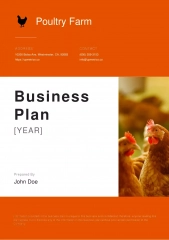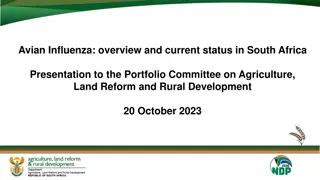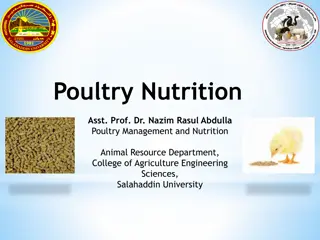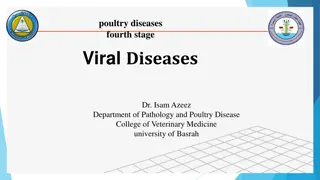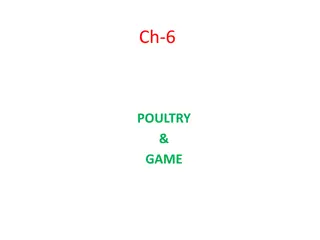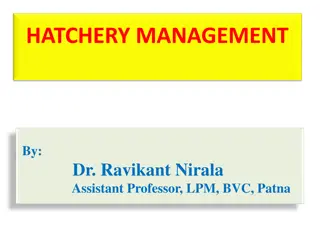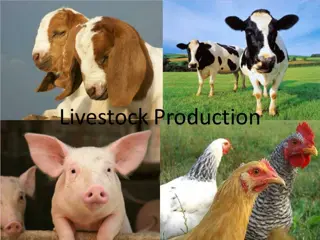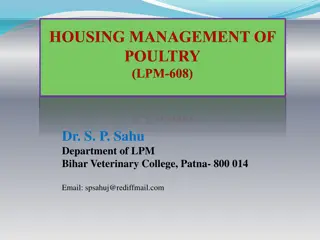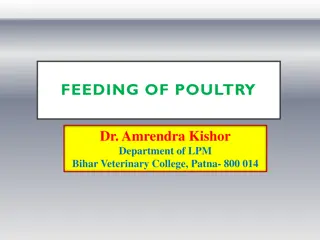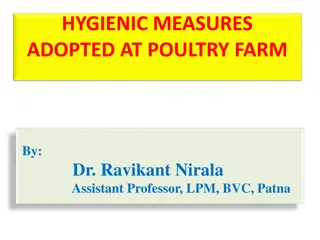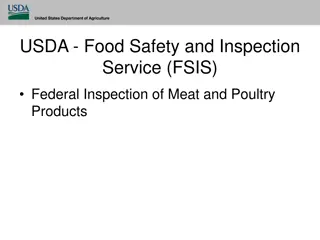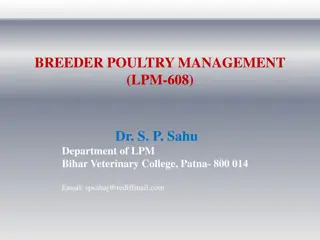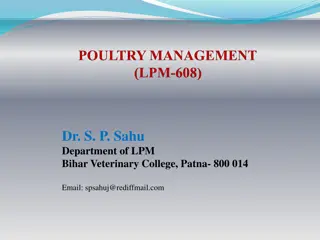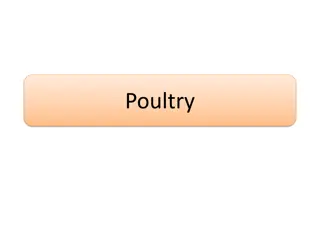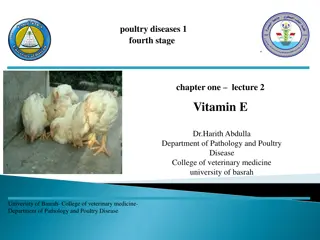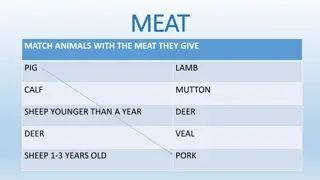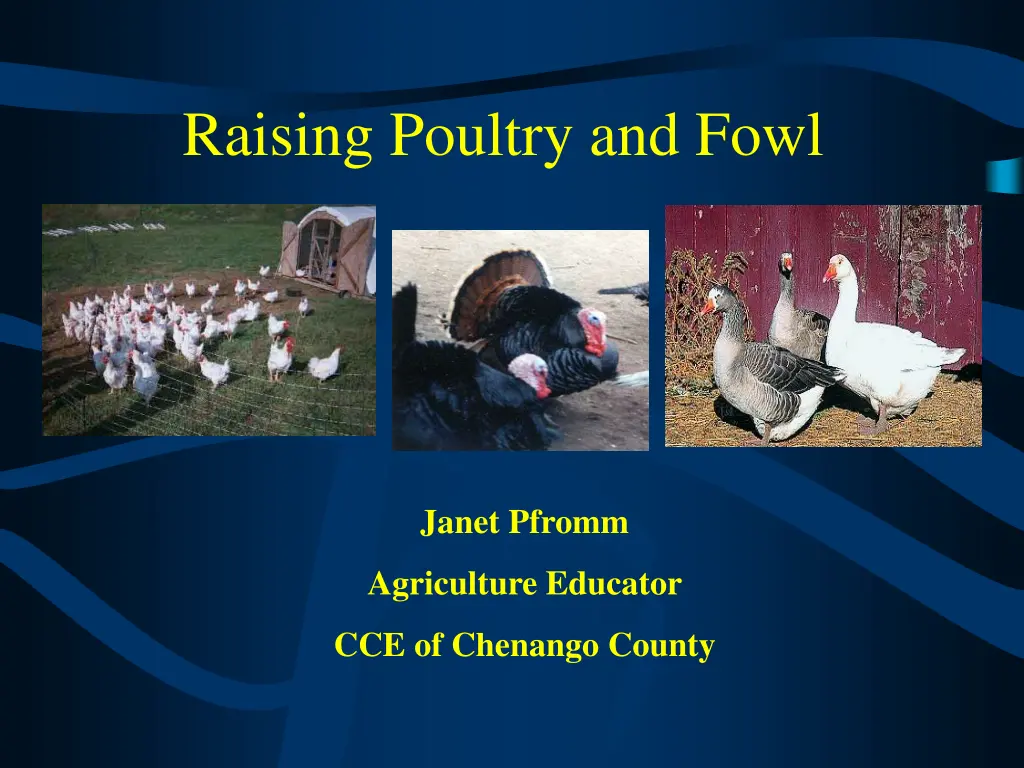
Raising Poultry and Fowl: Essential Guide for Beginners
Discover the complete process of raising poultry and fowl, from research and planning to housing and feeding requirements. Learn about brooding, managing mature birds, and the differences between meat and egg-producing birds. Essential tips and insights for aspiring poultry farmers.
Download Presentation

Please find below an Image/Link to download the presentation.
The content on the website is provided AS IS for your information and personal use only. It may not be sold, licensed, or shared on other websites without obtaining consent from the author. If you encounter any issues during the download, it is possible that the publisher has removed the file from their server.
You are allowed to download the files provided on this website for personal or commercial use, subject to the condition that they are used lawfully. All files are the property of their respective owners.
The content on the website is provided AS IS for your information and personal use only. It may not be sold, licensed, or shared on other websites without obtaining consent from the author.
E N D
Presentation Transcript
Raising Poultry and Fowl Janet Pfromm Agriculture Educator CCE of Chenango County
Where to Begin Research Intern at an existing business Develop a Business Plan
Getting Started Hatching your own eggs Buying chicks, poults, ducklings, and goslings
Raising Your Birds Brooding First 2 weeks Moving to Coop or Pasture Housing Feeding
Brooding Free from drafts, heat lamp, cardboard boxes, litter, feeder, and waterer
Housing Requirements (at mature or market size) Chicken Turkey Duck Goose Living space Feeder Space Water Space Pasture Size 1.5-4 sq. ft. per bird 4 in. per bird 1-1.5 in. per bird 500 broilers 1500 layers 8 sq. ft. per bird 6 in. per bird 1.5 in. per bird 250 birds/acre 2 sq. ft. per bird 3 in. per bird 1-2 in. per bird 30-40 birds/acre 5 sq. ft. per bird 5 in. per bird 2-3 in. per bird 30 birds/acre
Feeding Layers Meat Chickens 16% lay ration (2 lbs/bird/week) (2lbs/1lb of weight gain) Turkeys 26% growing ration after 4 wks of age, decrease protein as bird reaches market weight. 15-18% growing ration (dependent on grass avail) 15-18% growing ration (dependent on grass avail) Ducks 16-20% layer ration Geese All young birds should be a fed starter mash designed for the species. All should have free access to water at all time.
Meat Vs. Eggs Birds raised for meat are bred and fed for fast growth. Chickens (broilers): 4 lbs at 7-9 weeks 12-20 lbs at 12-20 weeks (roasters) Turkeys: 40 lbs at 22 weeks (toms) 24 lbs at 20 weeks (hens) Ducks: 5-7lbs at 8-9 weeks Geese: 6-12lbs at 15-20 weeks
Embden Large White Meat Birds Pekin Leghorn Blue Orpington
Laying birds mature later than meat birds. Not all layers are created equal! - Chickens will lay more than both ducks and geese - Chicken: 18-20 dozen/year - Duck: 12-16 dozen/year - Geese: 6 dozen/year - Breed differences among species Day length stimulates egg laying - Use of artificial light
Khaki Campbell Ancona Laying Birds Leghorn
Signs of Nutritional Problems Crusty Beak Eyes are Dull and Dry Feathers Lack Brightness of Color Cracked Feet Droopy Wings Decrease in Egg Production Poor Growth and Lack of Vigor Unexplained Death
Disease Problems Bio-security Sanitation Restricting Human Access Pullorum-Typhoid Testing: Must be done on poultry and waterfowl that are being shown at the county fair. Isolate new birds for one month Dispose of any birds after death Characteristics: Gasping for air
Molting Natural Shedding and Renewal of Feathers Usually Occurs with shorter day length (Fall) Signs of Molting will be a dullness in plumage During a Molt: Egg Production will Decrease Protein Needs will Increase
Organic and/or Pastured Poultry Organic Pastures need to be certified as Organic in order to label your product as Organic This can be an expensive process for only a few birds. Farm Grown Farm Fresh Locally Grown
Things to Consider Organic and/or Pastured Poultry Nutrient Distribution on Land Poultry can not survive on Grass, grains are necessary for growth Predators can be a concern Escapees Fencing For more info: Contact NOFA NY 607.724.9851 www.nofany.org
Questions??? Janet Pfromm Janet Pfromm Agriculture Educator Cornell Cooperative Extension of Chenango County 99 N. Broad St. Norwich, NY 13815 607-334-5841 - Extension 12 607-336-6961 Fax jlp27@cornell.edu

